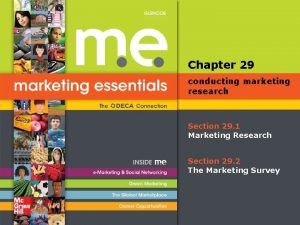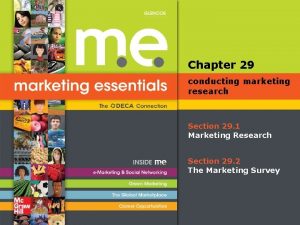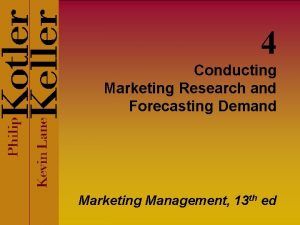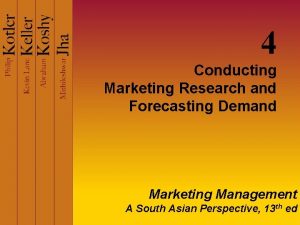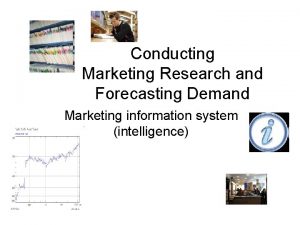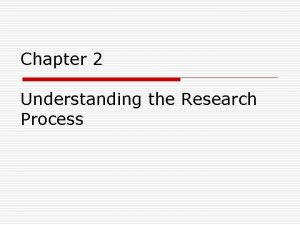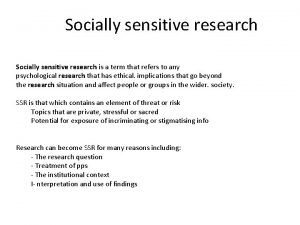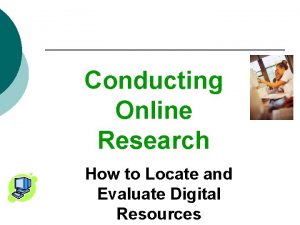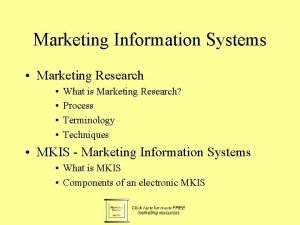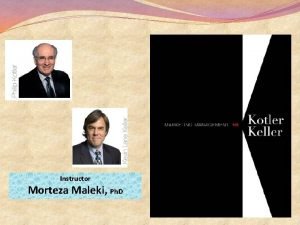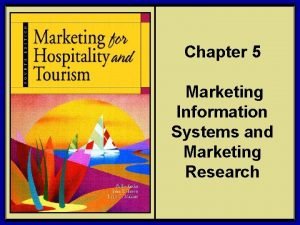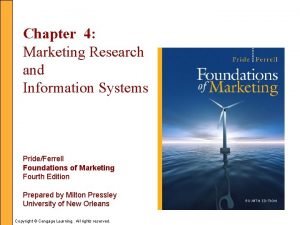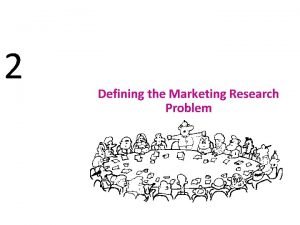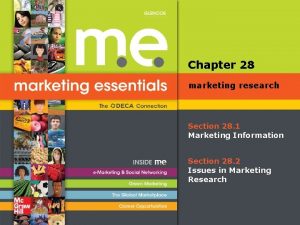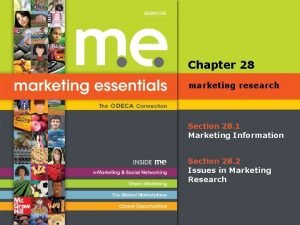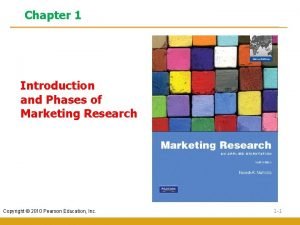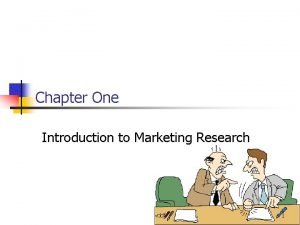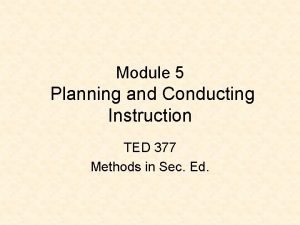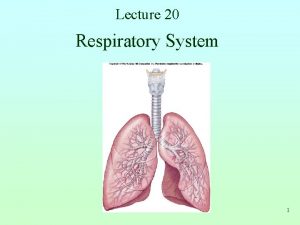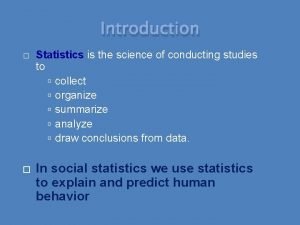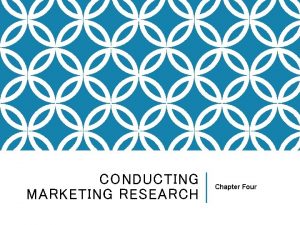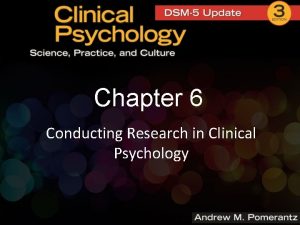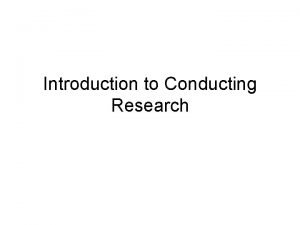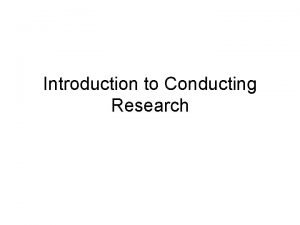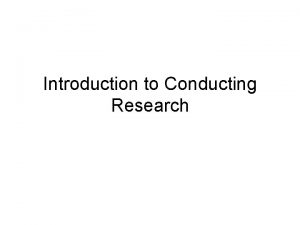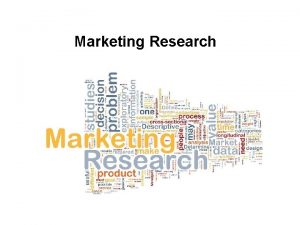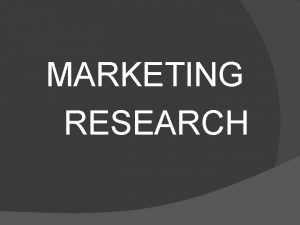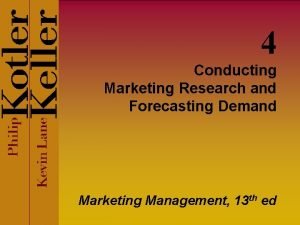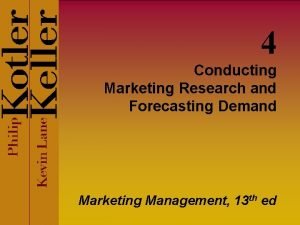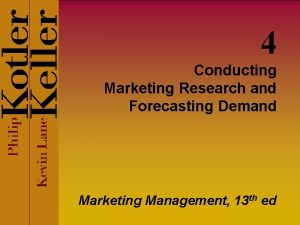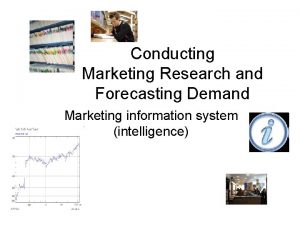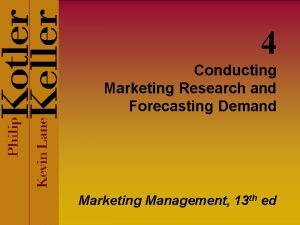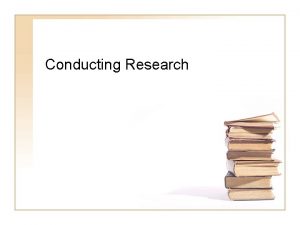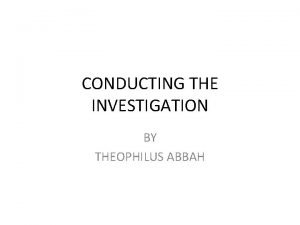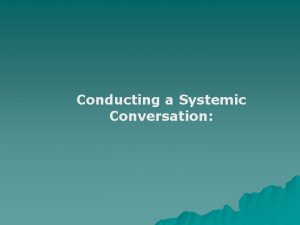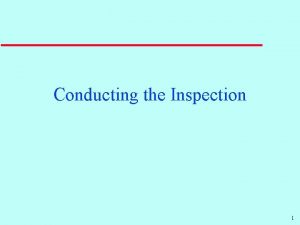Chapter 29 Conducting Marketing Research Marketing Research29 1





























- Slides: 29

Chapter 29 Conducting Marketing Research

Marketing Research-29. 1 l After finishing this section you will know: The steps in conducting marketing research l The difference between primary and secondary data l The various methods used to collect primary and secondary data l

The Marketing Research Process Step 1: Defining the Problem definition- when a business clearly identifies a problem or research issue and the information that is necessary to solve it l Example: Declining sales- The business needs to decide what it can do to improve sales. It will want to know who is buying its products, who are its present competitors, and why past customers stopped buying. The business will also need to know where, when, and why the product sells or does not sell. l l

The Marketing Research Process l l l The following questions are asked to focus on different parts of the marketing process: Are customers satisfied with the present product? Are prices competitive? Are the products distributed efficiently in the marketplace? Are promotion activities effective?

The Marketing Research Process l l l l Step 2: Obtaining Data are collected and examined in terms of the problem or problems being studied Data- facts Primary data- data obtained for the first time and used specifically for the particular problem or issue under study Secondary data- data that has already been collected for some purpose other than the current study Less expensive to collect than primary data Most effective for a company to decide what secondary data it will use before collecting primary data

The Marketing Research Process l l l How Secondary Data Are Obtained Internet Sources Digital dossiers- provide company profiles on public corporations, income statements, and balance sheets are available online These reports can be purchased for a fee from: Fortune 500 or Inc. 500 Online business clearinghouses- offer commercial directories and company resources Starting Point or Competitive Intelligence Guide

The Marketing Research Process U. S. Government Sources l Federal Government studies can provide useful information and statistics about markets, people, and business activities l This information can be accessed for free or for a small fee from Fed. World and The Federal Web Locator which are two Web directories with links to most government Web sites that provide such data. l Publications such as Census of the Population and the Statistical Abstract of the United States contain tables, graphs, and charts that can be useful when analyzing various business situations l

The Marketing Research Process Consumer and Business Information Companies l Syndicated services- research companies who offer secondary data for business needs l Example: Audit & Surveys Worldwide (ASW), which provides continuous monthly national measures of retail sales by brand. ASW also provides an annual update of the universe for all U. S. retail and service outlets from the National retail Census, which is the largest inperson distribution measurement program conducted in the United States. l

The Marketing Research Process l Business and Trade Publications l Secondary data can also be obtained in trade publications such as Forbes, Business Week, The Wall Street Journal, and Sales and Marketing Management l Data is published through articles, reports, and books

The Marketing Research Process l l Advantages of Secondary Data Secondary data can be obtained easily l l l Found on the Internet, in corporate, public, and college libraries Can also be obtained through the U. S. Bureau of the Census Disadvantages of Secondary Data Existing data may not be suitable or available for the problem under study Secondary data may sometimes be inaccurate Despite these disadvantages, businesses should try to find secondary data for free or at a low-cost

The Marketing Research Process l How Primary Data Are Obtained l Company research projects l Commercial research organizations l Primary research is collected using three methods l survey l observation l experiment

The Marketing Research Process l The Survey Method l Survey method- techniques in which information is gathered from people through the use of surveys l Most frequently used method l When designing a survey, marketers must determine the number of people to include in their survey

The Marketing Research Process l l l l Sample- the part of the target population that is assumed to represent the entire population The size of the sample depends upon the amount of money the company has to spend and the degree of accuracy that is needed The larger the sample, the greater the accuracy of the results Surveys can be conducted the following ways: In person By phone (personal or prerecorded) By mail (regular or email) By using Internet technologies

The Marketing Research Process l Personal interview- questioning people face-to-face usually in central locations such as shopping malls or airports l Also known as a mall intercept interview l Focus-group interview- eight to twelve people who are brought together to evaluate advertising, a particular product, package design, or a specific marketing strategy

The Marketing Research Process l l l Advantages of Personal Interviews Easier to get people to respond in person rather than by mail, phone, or Internet Interviewers are able to collect more complete answers Disadvantages of Personal Interviews Personal interviews are more expensive than the other methods It is very time consuming to tabulate results of personal interviews

The Marketing Research Process l l l Telephone interview Advantages of Telephone Interviews Quick, efficient, and relatively inexpensive Disadvantages of Telephone Interviews Some people are unwilling to respond l l Do not know caller Dislike responding to a prerecorded digital survey Resent the intrusion on their personal time Question how their answers will be used

The Marketing Research Process l l l l l Mail Survey Advantages of Mail Surveys Relatively inexpensive way to reach a potentially large audience Respondents are generally honest with their responses and find mail surveys less of an intrusion Disadvantages of Mail Surveys The average rate of return is only 10% Solutions to Low Response Rates for Mail Surveys Pre and post-survey reminder cards Offering incentives

The Marketing Research Process l l l Internet Surveys- include wide-open polls, anybody-can-answer polls, invitation-only surveys, password protected research sites, and Internet-based polls Advantages of Internet Surveys Quick and elimination of data entry because of automatically tabulated responses Disadvantages of Internet Surveys The use of Internet surveys is limited to those with Web access

The Marketing Research Process The Observation Method l Observation method- the actions of people are watched and recorded by cameras or observers l Mystery shopping- used to view interaction between customers and employees l A researcher who poses as a customer and goes into retail stores to observe employees l

l Sales l l people are observed on : Approach Sales presentation Product knowledge Suggestion selling

l l l Disadvantage of Observation Method It cannot measure attitudes or motivation The observation technique may use either contrived or natural situations Contrived situations- set up by the researcher Allow researchers to control a testing situation Respondents may not make the same choices as they would in a real buying situation

l l l Natural situations- customers or employees are viewed as they would normally act in a situation People or hidden cameras observe customers as they shop Traffic count- a count of people or cars as they pass by a store without looking, look and then pass, or stop, look, and enter Observation research is faster than personal interviews because participants do not have to be screened by telephone or scheduled for a particular time. Cost effective because businesses do not pay for postage, telephone costs, or participant fees

Point-of-sale research- powerful form of research that combines natural observation with personal interviews to get people to explain buying behavior l Researchers observe shoppers to decide which ones to choose as research subjects l Look for buyers buying a specific type of product, product brand, or who inspect a product but do not buy it l After observation, researchers approach the selected shoppers and ask them questions l

l l l The Experimental Method Experimental method- research technique in which a researcher observes the results of changing one or more marketing variables while keeping certain other variables constant under controlled conditions Used to test new package designs, media usage, and new promotions Infrequently used for marketing research due to the cost of setting up the research situation People respond differently under controlled conditions in contrast to actual buying situations

l l l Step 3: Analyzing the Data analysis- process of compiling, analyzing, and interpreting the results of primary and secondary data collection Step 4: Recommending Solutions to the Problem Successful research results in information that helps businesses make decisions on how to solve a problem Conclusions drawn from the research are usually presented in an organized and well-written report Recommendations must be clear and well supported by the research data

A typical research report includes the following: l Title page l Acknowledgements to people who assisted in the research effort l Tables, figures, charts, and graphs l Introduction l Procedures used in research l Findings l Recommendations l Summary and conclusions l Appendices l Bibliography

Step 5: Applying the Results l Managers use the research report to make decisions about marketing strategies in relation to the researched problem or issue l When evaluating the research, managers may find that the research was inconclusive and additional research may be needed l l The data collected does not solve the problem

After the research has been completed and recommendations acted upon, a business should carefully monitor the results l A business needs to know if the specific actions taken are successful l Marketing research is an ongoing process of problem solving l Information gathered through marketing research should become part of information available for making future business decisions l

Assignment l Page l #1 -6 532
 Chapter 29 conducting marketing research answers
Chapter 29 conducting marketing research answers What is forced choice questions
What is forced choice questions The marketing research process follows five steps
The marketing research process follows five steps Marketing research and forecasting demand
Marketing research and forecasting demand Conducting marketing research and forecasting demand
Conducting marketing research and forecasting demand Marketing information system
Marketing information system Conducting research steps
Conducting research steps Socially sensitive research
Socially sensitive research Naturalistic observation def
Naturalistic observation def When conducting research online the keyword
When conducting research online the keyword Finer segmentation
Finer segmentation Marketing information systems and marketing research
Marketing information systems and marketing research Define marketing information management
Define marketing information management Marketing information systems and marketing research
Marketing information systems and marketing research Marketing information system kotler
Marketing information system kotler Marketing information systems and marketing research
Marketing information systems and marketing research Management problem vs research problem
Management problem vs research problem Chapter 28 marketing research
Chapter 28 marketing research Chapter 28 marketing research
Chapter 28 marketing research Introduction to marketing research chapter 1
Introduction to marketing research chapter 1 Marketing research suppliers and services
Marketing research suppliers and services Respiratory zone and conducting zone
Respiratory zone and conducting zone Respiratory zone vs conducting zone
Respiratory zone vs conducting zone Conducting zone lungs
Conducting zone lungs Electric potential inside non conducting sphere
Electric potential inside non conducting sphere Planning and conducting instruction in the classroom
Planning and conducting instruction in the classroom What is the conducting zone of the respiratory system
What is the conducting zone of the respiratory system Statistics is the science of conducting studies to:
Statistics is the science of conducting studies to: What is a fair test in science
What is a fair test in science Electrostatic forces
Electrostatic forces
